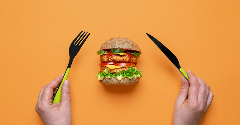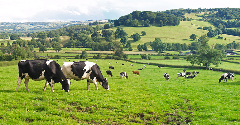News
Protein: It’s Not That Simple
24 Nov 2014Protein has become more than just a recommended part of meals and a shortcut to building muscle; its links to satiety have implicated it in weight management, and protein has now become the foundation of many diet plans. Attention to when protein should be consumed has become more of a focus as the application and use […]

Protein has become more than just a recommended part of meals and a shortcut to building muscle; its links to satiety have implicated it in weight management, and protein has now become the foundation of many diet plans. Attention to when protein should be consumed has become more of a focus as the application and use of protein continues to grow. Typically, protein intake is skewed towards the end of the day, with dinner providing the bulk of protein. Indeed, over 70% of UK and 61% of German consumers consume protein-containing food and drink products at dinner. The consumption of protein at other eating occasions is less frequent. Although 55% of German consumers claim to eat some protein at breakfast, less than a quarter of UK consumers claim to and only around 20% of those in Germany and the UK have protein-based snacks between meals. Research continues to support spreading protein consumption more evenly over a whole day as it positively affects muscle protein synthesis. This should encourage the inclusion of high protein ingredients into breakfast products, as well as snack products, to help consumers spread protein intake throughout the day.
Focusing on the UK, protein is used most as a tool in weight management and for building muscle. Of the consumers eating more protein, almost half – 47% – are doing so to help maintain a healthy weight and 42% have increased their protein intake to help them lose weight. Meanwhile, some 33% and 36% of UK consumers are eating more protein to help build muscle or maintain muscle mass respectively.
Different types of protein are better suited to certain applications. In applications related to physical activity, protein hydrolysates are considered the best source as the proteins are pre-digested into more digestible protein during processing – meaning they are digested into the bloodstream faster than whole, intact proteins. When looking to build muscle, whey protein hydrolysates are considered the best types of protein, as not only are they digested faster than casein or soy proteins but they stimulate protein synthesis to a greater degree. However, the slow-absorbing protein casein is more suited to improving overnight post-exercise recovery, delivering a slower, more continuous stream of protein. This also has implications for products making satiety claims, as casein has a slower but longer and more sustained effect on satiety compared with whey.
The source of protein is also relevant in the growing pool of mainstream products making high protein claims. Wholefoods naturally high in protein are being utilised more for their high protein content, with Greek yoghurt, ancient grains (such as quinoa, chia and teff), and pulses, grains and seeds such as pea, maize, rice, hemp, lupin and linseed being used more for their protein content. Aligning the type of protein used in products with different consumer goals should help consumers reach their targets easier. Given the wider range of benefits being linked to protein, high protein products should not just focus on their protein content but use more tailored messages that call out the specific benefits the product can provide. Manufacturers should explore new formats to deliver protein to consumers, particularly breakfast products and snacks to help spread protein intake more evenly across a day. Also, the type of protein used should be aligned with consumers’ specific goals.
Related news

Has ‘clean’ had its day?
22 Dec 2025
Wielding clean-label positioning and fortification as marketing levers is a dangerous strategy, and brands would be better off explaining the hows and whys of the ingredients in their products, say experts.
Read more
Celebrating the winners of the Fi Europe Innovation Awards 2025
3 Dec 2025
Food industry stakeholders celebrated as the winners of the Fi Europe Innovation Awards were announced at a ceremony in Paris.
Read more
Alternative protein startups pivot to B2B ingredients amid funding shift
27 Nov 2025
Alt protein startups are pivoting from consumer meat analogues to high-value B2B ingredients, driven by stronger investor interest, better margins, and clearer commercial pathways.
Read more
Walmart Marketplace’s record growth prompts search for UK sellers
26 Sep 2025
Walmart’s third-party e-commerce platform, Marketplace, has witnessed extraordinary growth – but a need for more product diversity has prompted the retailer to recruit UK sellers.
Read more
The winners of Vitafoods Europe Startup Challenge 2025 revealed
29 May 2025
Four startups – Yomio Drops, PFx Biotech, Revobiom, and Favamole – took top prizes at this year’s Vitafoods Europe Startup Challenge awards.
Read more
East takes on West in the fight for future food flavours
30 Apr 2025
Asian and South American flavours are now key components on global menus, driven by a growing global appetite for culinary mashups.
Read more
Food companies urged to bring ‘joy’ and urgency to healthy food mission
14 Mar 2025
For too long, businesses have treated health and sustainability as separate agendas – but there is growing evidence to show diets that benefit human health can also enhance that of the planet, say experts.
Read more
Entries open for inaugural Vitafoods Europe Innovation Awards
29 Jan 2025
Entries are open for the inaugural Vitafoods Europe Innovation Awards, celebrating the ingredients, finished products, partnerships, and initiatives redefining the nutraceutical landscape.
Read more
Paris Olympics: Food and beverage brands champion health, fun, and sustainability
5 Aug 2024
Food and beverage brands are aligning with the Paris Olympics 2024 Food Vision, which emphasises sustainability, local sourcing, and plant-based diets.
Read more
Natural Remedies: Bringing health and happiness via validated branded ingredients
18 Apr 2024
Natural Remedies is an internationally renowned botanical healthcare company committed to advancing the field through rigorous research and the development of clinically validated Branded Ingredients. Guided by our foundational principle of ‘BEING USEF...
Read more